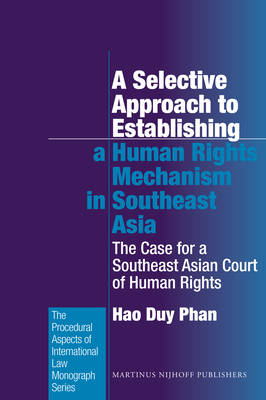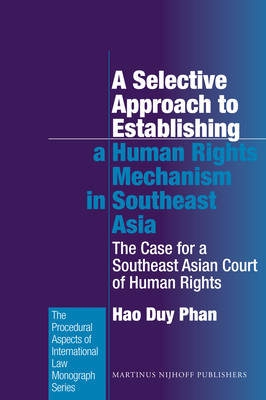
- Afhalen na 1 uur in een winkel met voorraad
- Gratis thuislevering in België vanaf € 30
- Ruim aanbod met 7 miljoen producten
- Afhalen na 1 uur in een winkel met voorraad
- Gratis thuislevering in België vanaf € 30
- Ruim aanbod met 7 miljoen producten
Zoeken
A Selective Approach to Establishing a Human Rights Mechanism in Southeast Asia
The Case for a Southeast Asian Court of Human Rights
Hao Duy Phan
€ 222,95
+ 445 punten
Omschrijving
This book proposes a selective approach for states with more advanced human rights protection to establish a human rights court for Southeast Asia. It argues the inclusive approach currently employed by ASEAN to set up a human rights body covering all member states cannot produce a strong regional human rights mechanism. The mosaic of Southeast Asia reveals great diversity and high complexity in political regimes, human rights practice and participation by regional states in the global legal human rights framework. Cooperation among ASEAN members to protect and promote human rights remains limited. The time-honored principle of non-interference and the "ASEAN Way" still predominate in relations within ASEAN. These factors combine to explain why the ASEAN Intergovernmental Commission on Human Rights is unlikely to be strong and effective in changing and promoting regional human rights protection.
This book suggests a selective approach to establish a human rights court for Southeast Asia. It posits that a group of nations within Southeast Asia may be more willing to consider the possibility of a stronger human rights mechanism. It investigates the challenges to and the feasibility of such a proposal. Furthermore, it examines the design of the three existing regional human rights courts in Europe, the Americas, and Africa, and compares the rationales for those institutional designs with the specific context of Southeast Asia. A human rights court for all ASEAN members may not be possible at this time, but a court for some nations in the region is feasible and worth exploring. The path towards this goal is never an easy one; however, the region possesses the necessary conditions to gradually translate that goal into reality.
This book suggests a selective approach to establish a human rights court for Southeast Asia. It posits that a group of nations within Southeast Asia may be more willing to consider the possibility of a stronger human rights mechanism. It investigates the challenges to and the feasibility of such a proposal. Furthermore, it examines the design of the three existing regional human rights courts in Europe, the Americas, and Africa, and compares the rationales for those institutional designs with the specific context of Southeast Asia. A human rights court for all ASEAN members may not be possible at this time, but a court for some nations in the region is feasible and worth exploring. The path towards this goal is never an easy one; however, the region possesses the necessary conditions to gradually translate that goal into reality.
Specificaties
Betrokkenen
- Auteur(s):
- Uitgeverij:
Inhoud
- Aantal bladzijden:
- 288
- Taal:
- Engels
- Reeks:
- Reeksnummer:
- nr. 29
Eigenschappen
- Productcode (EAN):
- 9789004222168
- Verschijningsdatum:
- 3/02/2012
- Uitvoering:
- Hardcover
- Formaat:
- Genaaid
- Afmetingen:
- 168 mm x 244 mm
- Gewicht:
- 612 g

Alleen bij Standaard Boekhandel
+ 445 punten op je klantenkaart van Standaard Boekhandel
Beoordelingen
We publiceren alleen reviews die voldoen aan de voorwaarden voor reviews. Bekijk onze voorwaarden voor reviews.








